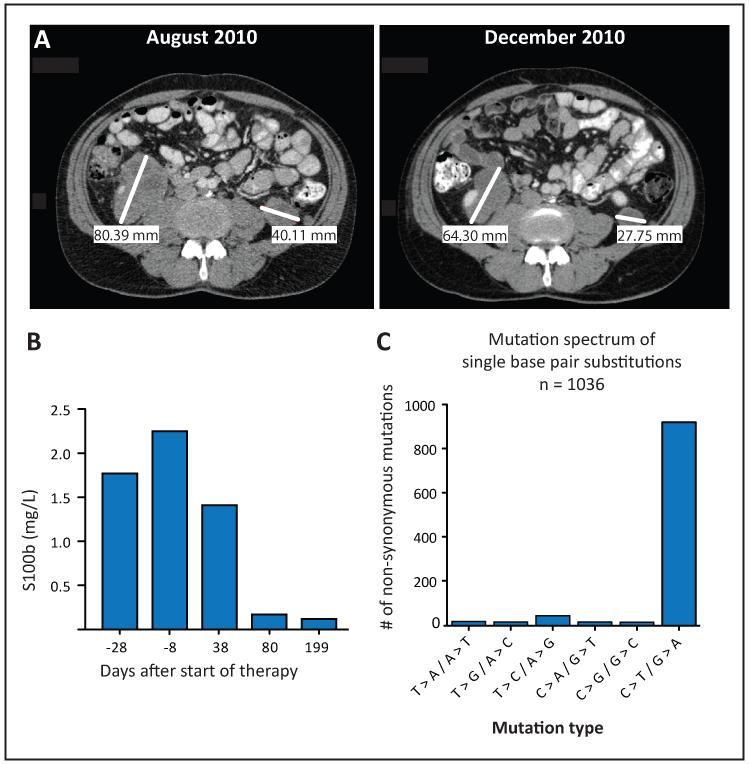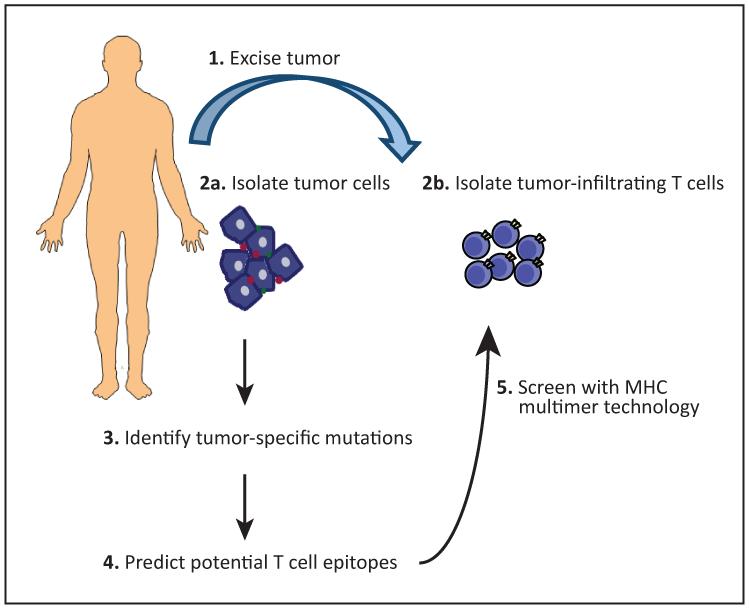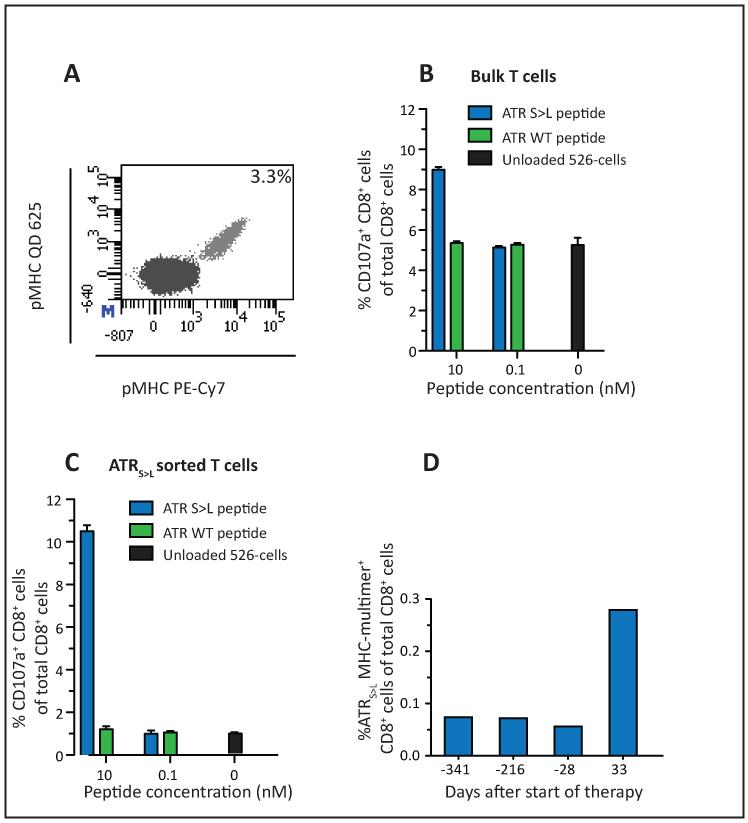The evidence for T-cell–mediated regression of human cancers such as non–small-cell lung carcinoma, renal cell carcinoma, and—in particular—melanoma after immunotherapy is strong. Anti-CTLA4 (ipilimumab) treatment has been approved for treatment of meta-static melanoma,1 and antibody-mediated blockade of PD-1, a second inhibitory receptor on T cells, has shown highly encouraging results in early clinical trials.2,3 Although the clinical activity of these treatments is apparent, it is still unknown which T-cell reactivities are involved in immunotherapy-induced cancer regression.4 T-cell reactivity against nonmutated tumor-associated self-antigens has been analyzed in patients treated with ipilimumab or with autologous tumor-infiltrating T cells, but the magnitude of the T-cell responses observed has been relatively modest.5,6 In part on the basis of such data, recognition of patient-specific mutant epitopes (hereafter referred to as neoantigens) has been suggested to be a potentially important component.7 A potential involvement of mutated epitopes in T-cell control would also fit well with the observation that the mutation load in sun-exposed melanomas is particularly high.8-10
Intriguingly, on the basis of animal model data, it has recently been suggested that (therapy-induced) analysis of T-cell reactivity against patient-specific neoantigens may be feasible through exploitation of cancer genome data.11,12 However, human data have thus far been lacking. Here we report a case of a patient with stage IV melanoma who exhibited a clinical response to ipilimumab treatment. Cancer exome–guided analysis of T-cell reactivity in this patient revealed reactivity against two neoantigens, including a dominant T-cell response against a mutant epitope of the ATR (ataxia telangiectasia and Rad3 related) gene product that increased strongly after ipilimumab treatment. These data provide the first demonstration (to our knowledge) of cancer exome–guided analysis to dissect the effects of melanoma immunotherapy.
Case Report
A 56-year-old male was diagnosed in 2003 with a nodular melanoma with a Breslow thickness of 1.5 mm on the left upper arm. In April 2009, he developed lymph node metastases in both axillae and underwent dissection of involved nodes at the right side. Positron emission tomography showed [18F]fluorodeoxyglucose uptake in both axillae, in soft tissue at the right scapula, in the left liver lobe, and mesenterially cranial of the transverse colon. He was treated with dacarbazine but experienced clear disease progression after six courses. At that time (October 2009), as a result of discomfort, a palliative dissection of the left axillary nodes was performed. In June 2010, before enrollment in the ipilimumab Expanded Access Pro-gram, magnetic resonance imaging of the brain showed three lesions, of which one was resected and two others were treated with stereotac-tic radiotherapy. In August 2010, he started ipilimumab treatment (3 mg/kg) and received four infusions. All four courses of ipilimumab were tolerated well, except for grade 1 dermatitis. After completion, the patient displayed a marked regression of the tumor load (25%), as shown by computed tomography (Fig 1A) and close to normalization (upper limit of normal 0.10 g/L) of the S100b tumor marker after ipilimumab treatment (Fig 1B).
Figure 1.
Patient characteristics
To determine whether exome-guided analysis of antigen-specific T-cell responses against mutated antigens was feasible, we obtained both tumor cells and tumor-infiltrating lymphocytes (TILs) from the lesion resected in 2009. Whole-exome sequencing of tumor cells and autologous healthy tissue was performed to identify tumor-specific mutations. This revealed a total of 1,657 somatic mutations, consisting of 1,075 nonsynonymous (1,036 single nucleotide and 39 nonsense variants) and 573 synonymous mutations with a false discovery rate of 0.07. In addition, the tumor harbored seven frame shifts and two codon deletions. Consistent with prior data, C T/G A mutations, reflective of UV-induced DNA damage, predominated (Fig 1C).8-10 To predict potential neoantigens from this set of mutations, the data were first filtered for gene expression using RNAseq data. Subsequently, predictions for proteasomal processing and HLA class I bind-ing were performed on stretches of amino acid sequences that contained nonsynonymous mutations, using the NetChop Cterm3.0 and NetMHC3.2 algorithms.13-15 This analysis yielded a set of 448 potential CD8 T-cell epitopes (nine to 11 amino acids in length) with a predicted medium-to-high affinity binding for each HLA-A and -B allele (HLA-A*03:01, HLA-A*32:01, HLA-B*35:03, and HLA-B*40: 02). Predicted peptides were synthesized, and HLA multimers containing these ligands were produced by micro-scale parallel UV-induced peptide exchange reactions.16,17 Subsequently, tumor-infiltrating lymphocytes from this patient were analyzed for reactivity against these predicted T-cell epitopes by a multiplexed major histo-compatibility complex (MHC) multimer staining strategy.16,18,19 An overview of the complete screening procedure can be found in Figure 2 (MHC, major histocompatibility complex).
Figure 2.
Overview of screening procedure
This analysis revealed a T-cell response against two patient-specific neoantigens (both confirmed in independent analyses), a mi-nor T-cell response against a mutated epitope in the ZNF462 gene (0.003% of CD8-positive cells) that was not pursued further, and a dominant response (3.3% of CD8-positive cells, Fig 3A; Cy7, cytochrome 7; PE-Cy7, R-Phycoerythrincyanine 7; pMHC, peptide MHC; QD, Qdot 625; WT, wild type) against a mutated epitope in the ATR serine/threonine protein kinase that functions to signal DNA damage.20 This mutation in ATR, resulting in an S L change at position eight of a nonameric HLA-A*03:01 restricted epitope (ATRS>L KLYEEPLLK) was heterozygous within the tumor (66% of reads obtained, n=298) but absent in healthy control tissue (0%, n=189).
Figure 3.
Functional characterization of ATRS>L specific T cells
In order to assess whether the observed T cells were specific for the mutant ATRS>L epitope, bulk TILs were cocultured with HLA-A*03:01-matched melanoma cells (526 cells). In the absence of added peptide, a low level of T-cell reactivity was observed, presumably reflecting recognition of shared (ie, nonmutated) HLA-A*03:01-restricted antigens (Fig 3B). Importantly, whereas addition of wild-type ATR peptide was without effect, addition of the ATRS>L peptide led to a substantial increase in T-cell recognition. Furthermore, sorted ATRS>L MHC multimer-positive T cells likewise showed strong reac-tivity against target cells loaded with the mutant epitope but not with the wild-type peptide (Fig 3C).
Having established the presence of neoantigen-specific T-cell reactivity on the basis of cancer exome data, we subsequently assessed whether this information could be used to monitor treatment-induced T-cell reactivity. To this purpose, peripheral blood mononuclear cell samples collected before (341 days, 216 days, 28 days) and during (33 days) ipilimumab therapy were analyzed by ATRS L MHC multimer staining. HLA-A*03:01 ATRS>L-specific T cells could be detected in peripheral blood at the earliest time point available and remained stable for a 10-month period preceding the start of ipilimumab treatment. Remarkably, within 5 weeks after the start of ipilimumab, the magnitude of this neoantigen-specific T-cell response increased five-fold (Fig 3D), demonstrating that autologous cancer exome data can be used not only to predict neoantigens in patients, but also to monitor the effects of immunotherapy.
Discussion
To our knowledge, this is the first report to show how autologous cancer exome data can be used to reveal T-cell responses against patient-specific neoantigens in humans. The ATRS>L-specific T-cell response was identified in purposively comprehensive analysis, in which all genes with RNA expression above 0 were used for epitope prediction, and in which all neoantigens with at least an intermediate predicted HLA affinity were retained. Interestingly, analysis of RNA expression of the ATR gene and the predicted HLA binding affinity of the ATRS>L mutant epitope revealed that ATR was in the top 28% of expressed genes and that the ATRS>L epitope was in the top 4% of predicted HLA-A*03:01-restricted epitopes. In case this reflects a more general bias toward recognition of neoantigens from highly expressed genes with a high predicted HLA binding affinity, it may in future studies be feasible to analyze patient-specific T-cell reactivity with even relatively small peptide sets. Analysis of larger groups of patients will be useful to address this issue.
Recent work of the groups of Schreiber and Sahin11,12 in animal model systems have provided the first indications how cancer exome data may be used for immunotherapy, by demonstrating not only that vaccination against neoantigens within a mouse melanoma model can be used to increase tumor control, but also that immune-based selection against such neoantigens can lead to epitope loss in vivo. Here we provide, to our knowledge, the first demonstration of the feasibility of exome-driven analysis of tumor-specific T-cell reactivity in human cancer. In the coming years, it will be interesting to assess how such information can be used as a potential diagnostic strategy, as well as for the develop-ment of personalized cancer immunotherapy.21
Supplementary Material
ACKNOWLEDGMENT
After acceptance of this manuscript, Robbins et al22 demonstrated how mutated antigens that are recognized by adoptively transferred tumor-reactive T cells can also be identified with the use of exomic sequencing data.
Supported by grants from the Danish Strategic Research Council and the Dutch Cancer Society (Netherlands Cancer Institute 2012-5463). We thank members from the Schumacher and Haanen laboratories for useful discussions.
Footnotes
AUTHORS’ DISCLOSURES OF POTENTIAL CONFLICTS OF INTEREST
Although all authors completed the disclosure declaration, the following author(s) and/or an author’s immediate family member(s) indicated a financial or other interest that is relevant to the subject matter under consideration in this article. Certain relationships marked with a “U” are those for which no compensation was received; those relationships marked with a “C” were compensated. For a detailed description of the disclosure categories, or for more information about ASCO’s conflict of interest policy, please refer to the Author Disclosure Declaration and the Disclosures of Potential Conflicts of Interest section in Information for Contributors.
Employment or Leadership Position: None Consultant or Advisory Role: None Stock Ownership: None Honoraria: None Research Funding: John B. Haanen, Bristol-Myers Squibb Expert Testimony:
None Patents: None Other Remuneration: None
Contributor Information
Nienke van Rooij, Netherlands Cancer Institute, Amsterdam, the Netherlands.
Marit M. van Buuren, Netherlands Cancer Institute, Amsterdam, the Netherlands
Daisy Philips, Netherlands Cancer Institute, Amsterdam, the Netherlands.
Arno Velds, Netherlands Cancer Institute, Amsterdam, the Netherlands.
Mireille Toebes, Netherlands Cancer Institute, Amsterdam, the Netherlands.
Bianca Heemskerk, Netherlands Cancer Institute, Amsterdam, the Netherlands.
Laura J.A. van Dijk, Netherlands Cancer Institute, Amsterdam, the Netherlands
Sam Behjati, Wellcome Trust Sanger Institute, Cambridge, United Kingdom.
Henk Hilkmann, Netherlands Cancer Institute, Amsterdam, the Netherlands.
Dris el Atmioui, Netherlands Cancer Institute, Amsterdam, the Netherlands.
Marja Nieuwland, Netherlands Cancer Institute, Amsterdam, the Netherlands.
Michael R. Stratton, Wellcome Trust Sanger Institute, Cambridge, United Kingdom
Ron M. Kerkhoven, Netherlands Cancer Institute, Amsterdam, the Netherlands
Can Kesmir, Utrecht University, Utrecht, the Netherlands.
John B. Haanen, Netherlands Cancer Institute, Amsterdam, the Netherlands
Pia Kvistborg, Netherlands Cancer Institute, Amsterdam, the Netherlands.
Ton N. Schumacher, Netherlands Cancer Institute, Amsterdam, the Netherlands
REFERENCES
- 1.Hodi FS, O’Day SJ, McDermott DF, et al. Improved survival with ipili-mumab in patients with metastatic melanoma. N Engl J Med. 2010;363:711–723. doi: 10.1056/NEJMoa1003466. [DOI] [PMC free article] [PubMed] [Google Scholar]
- 2.Brahmer JR, Tykodi SS, Chow LQ, et al. Safety and activity of anti-PD-L1 antibody in patients with advanced cancer. N Engl J Med. 2012;366:2455–2465. doi: 10.1056/NEJMoa1200694. [DOI] [PMC free article] [PubMed] [Google Scholar]
- 3.Topalian SL, Hodi FS, Brahmer JR, et al. Safety, activity, and immune correlates of anti-PD-1 antibody in cancer. N Engl J Med. 2012;366:2443–2454. doi: 10.1056/NEJMoa1200690. [DOI] [PMC free article] [PubMed] [Google Scholar]
- 4.Heemskerk B, Kvistborg P, Schumacher TN. The cancer antigenome. EMBO J. 2013;32:194–203. doi: 10.1038/emboj.2012.333. [DOI] [PMC free article] [PubMed] [Google Scholar]
- 5.Kvistborg P, Shu CJ, Heemskerk B, et al. TIL therapy broadens the tumor-reactive CD8+ T cell compartment in melanoma patients. Oncoimmu-nology. 2012;1:409–418. doi: 10.4161/onci.18851. [DOI] [PMC free article] [PubMed] [Google Scholar]
- 6.Yuan J, Adamow M, Ginsberg BA, et al. Integrated NY-ESO-1 antibody and CD8 T-cell responses correlate with clinical benefit in advanced melanoma patients treated with ipilimumab. Proc Natl Acad Sci U S A. 2011;108:16723–16728. doi: 10.1073/pnas.1110814108. [DOI] [PMC free article] [PubMed] [Google Scholar]
- 7.Segal NH, Parsons DW, Peggs KS, et al. Epitope landscape in breast and colorectal cancer. Cancer Res. 2008;68:889–892. doi: 10.1158/0008-5472.CAN-07-3095. [DOI] [PubMed] [Google Scholar]
- 8.Hodis E, Watson IR, Kryukov GV, et al. A landscape of driver mutations in melanoma. Cell. 2012;150:251–263. doi: 10.1016/j.cell.2012.06.024. [DOI] [PMC free article] [PubMed] [Google Scholar]
- 9.Krauthammer M, Kong Y, Ha BH, et al. Exome sequencing identifies recurrent somatic RAC1 mutations in melanoma. Nat Genet. 2012;44:1006–1014. doi: 10.1038/ng.2359. [DOI] [PMC free article] [PubMed] [Google Scholar]
- 10.Wei X, Walia V, Lin JC, et al. Exome sequencing identifies GRIN2A as frequently mutated in melanoma. Nat Genet. 2011;43:442–446. doi: 10.1038/ng.810. [DOI] [PMC free article] [PubMed] [Google Scholar]
- 11.Castle JC, Kreiter S, Diekmann J, et al. Exploiting the mutanome for tumor vaccination. Cancer Res. 2012;72:1081–1091. doi: 10.1158/0008-5472.CAN-11-3722. [DOI] [PubMed] [Google Scholar]
- 12.Matsushita H, Vesely MD, Koboldt DC, et al. Cancer exome analysis reveals a T-cell-dependent mechanism of cancer immunoediting. Nature. 2012;482:400–404. doi: 10.1038/nature10755. [DOI] [PMC free article] [PubMed] [Google Scholar]
- 13.Lundegaard C, Lamberth K, Harndahl M, et al. NetMHC-3.0: Accurate web accessible predictions of human, mouse and monkey MHC class I affinities for peptides of length 8-11. Nucleic Acids Res. 2008;36:W509–W512. doi: 10.1093/nar/gkn202. [DOI] [PMC free article] [PubMed] [Google Scholar]
- 14.Nielsen M, Lundegaard C, Worning P, et al. Improved prediction of MHC class I and class II epitopes using a novel Gibbs sampling approach. Bioinformatics. 2004;20:1388–1397. doi: 10.1093/bioinformatics/bth100. [DOI] [PubMed] [Google Scholar]
- 15.Nielsen M, Lundegaard C, Lund O, et al. The role of the proteasome in generating cytotoxic T-cell epitopes: Insights obtained from improved predictions of proteasomal cleavage. Immunogenetics. 2005;57:33–41. doi: 10.1007/s00251-005-0781-7. [DOI] [PubMed] [Google Scholar]
- 16.Rodenko B, Toebes M, Hadrup SR, et al. Generation of peptide-MHC class I complexes through UV-mediated ligand exchange. Nat Protoc. 2006;1:1120–1132. doi: 10.1038/nprot.2006.121. [DOI] [PubMed] [Google Scholar]
- 17.Toebes M, Coccoris M, Bins A, et al. Design and use of conditional MHC class I ligands. Nat Med. 2006;12:246–251. doi: 10.1038/nm1360. [DOI] [PubMed] [Google Scholar]
- 18.Hadrup SR, Bakker AH, Shu CJ, et al. Parallel detection of antigen-specific T-cell responses by multidimensional encoding of MHC multimers. Nat Methods. 2009;6:520–526. doi: 10.1038/nmeth.1345. [DOI] [PubMed] [Google Scholar]
- 19.Andersen RS, Kvistborg P, Frøsig TM, et al. Parallel detection of antigen-specific T cell responses by combinatorial encoding of MHC multimers. Nat Protoc. 2012;7:891–902. doi: 10.1038/nprot.2012.037. [DOI] [PubMed] [Google Scholar]
- 20.Cimprich KA, Cortez D. ATR: An essential regulator of genome integrity. Nat Rev Mol Cell Biol. 2008;9:616–627. doi: 10.1038/nrm2450. [DOI] [PMC free article] [PubMed] [Google Scholar]
- 21.Kroemer G, Zitvogel L. Can the exome and the immunome converge on the design of efficient cancer vaccines? Oncoimmunology. 2012;1:579–580. doi: 10.4161/onci.20730. [DOI] [PMC free article] [PubMed] [Google Scholar]
- 22.Robbins PF, Lu YC, El-Gamil M, et al. Mining exomic sequencing data to identify mutated antigens recognized by adoptively transferred tumor-reactive T cells. Nat Med. 2013;19:747–752. doi: 10.1038/nm.3161. [DOI] [PMC free article] [PubMed] [Google Scholar]
Associated Data
This section collects any data citations, data availability statements, or supplementary materials included in this article.





